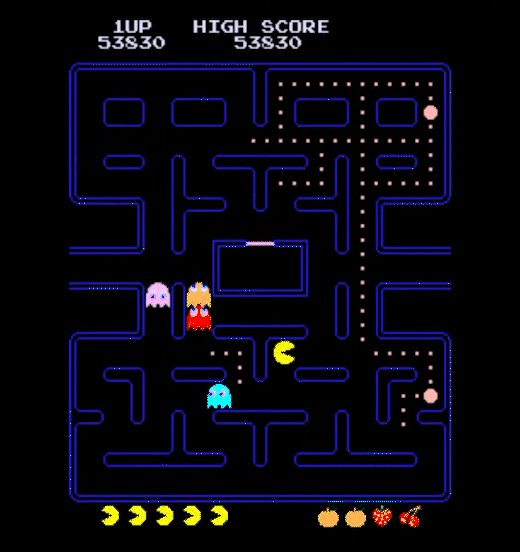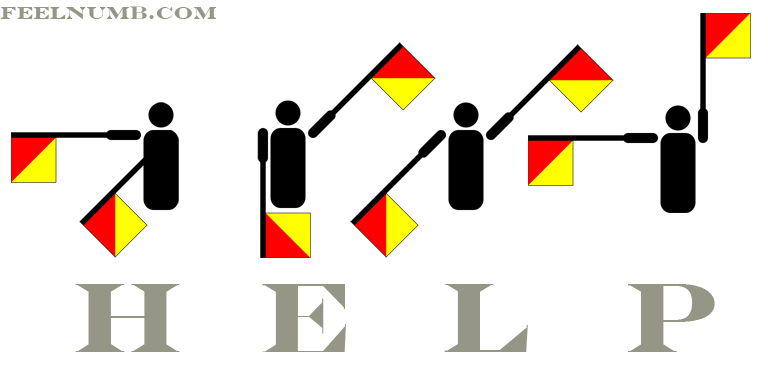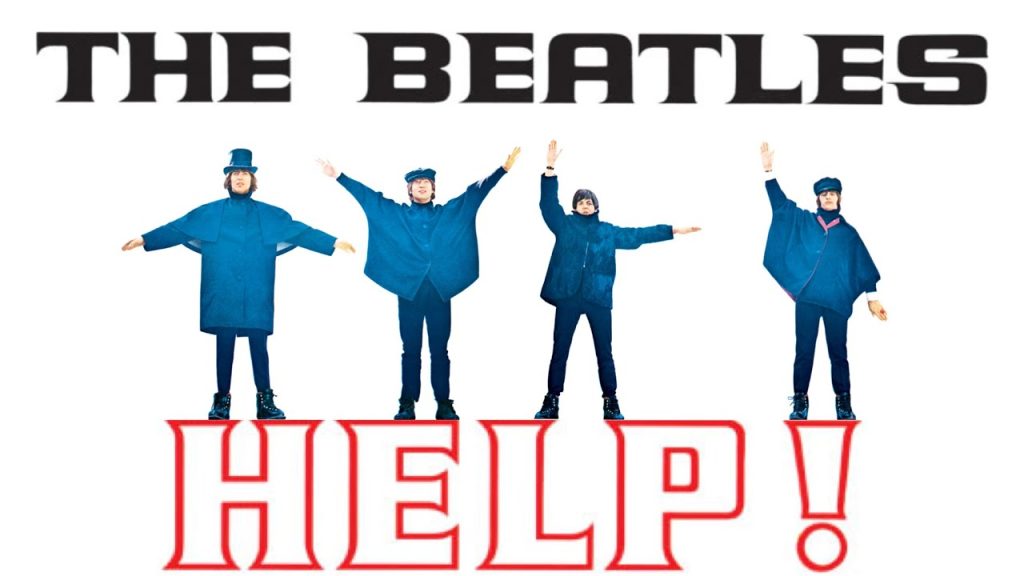If you came here wondering whether that hot new “Pac-Man” game lives up to the hype, then wonder no more. The verdict is in, and Pac-Man gets an epic two thumbs up out of ten!
This game is suitable for children of all ages (stone, bronze, iron, classical, dark, middle, and early modern), teaching them them the only lesson they need to know in life: how to pop pills to keep your persistent spectral hallucinations at bay. Pac-Man is absolutely stuffed with the latest, hottest features we “game-heads” crave. It has graphics! And little plastic buttons you can press! Often, when you press the buttons, things happen on the screen. Cool! You can even eat the buttons, although they don’t taste very good.
I own an original Pac-Man arcade cabinet from the 80s. It belonged to my father, who was into retro gaming gear (well, it wasn’t retro when he bought it, but you get the idea). I think it’s one of the earliest cabinets manufactured by Namco—it has Puck-Man on the front (the game’s original title), and the serial on the base is #341.

It’s in excellent condition, although I had to replace a bad capacitor on the PCB a few years ago. This rare and well-preserved cabinet would be worth a pretty penny if I wanted to sell it, but I like playing the damned thing too much. Your firstborn child would be worth a pretty penny on the open market too, particularly if they still had both kidneys, but does that move the needle? Are you thinking “man, I could totally refinance my mortgage, and it’d be less Paw Patrol I have to listen to”? Yeah, I didn’t think so. Some things are more important than money.
Pac-Man is a look back at a more innocent time. Namco would later attract controversy with poorly-advised spin-offs such as Mrs Pac-Man (your character earns 70% of the points the male Pac-Man does), Frac-Man (you fix leaks on a pipeline while avoiding angry protestors), Blac-Man (you swallow ghosts with your huge red lips), Barebac-Man (the ghosts are HIV viruses), and, most alarmingly, NSDAP-Man (the ghosts are far harder to avoid due to their long, hooked noses and control over the world’s banks), but the original remains a timeless classic. Sometimes all a guy wants is good old-fashioned Pac-Man, the way it was meant to be.
Except, well…
Something’s wrong with my game. It’s hard to explain. Maybe the cabinet is bugged. Maybe it was tampered with by my father or someone else. Maybe it’s not really a Pac-Man cabinet at all. I can’t say for sure, but there’s something a little unusual about the ghosts in my machine.
First, let’s review how Pac-Man’s ghosts work. Puck-Man, like its English counterpart, has four of them. They are called Oikake (追いかけ), Machibuse (待ち伏せ), Kimagure (気まぐれ), and Otoboke (お惚け).
Their purpose is to chase Pac-Man, but Toru Iwatani (the game’s creator) realized that Pac-Man wouldn’t be fun if the ghosts just ran at you blindly. They’d end up following you around in a conga line, and the game would be too easy. In a brilliant masterstroke, he programmed them with unique AIs. Each ghost has a distinct personality, and tries to catch you with a different trick.
Oikake (the red ghost) is the simplest: he charges like a dumbfire missile toward Pac-Man’s current square (path calculated by D = sqrt((x_Pac-Man – x_Oikake)^2 + (y_Pac-Man – y_Oikake)^2)). Otoboke (the orange ghost) behaves like Oikake, but if Pac-Man is equal or less than 8 squares away he runs to the maze’s bottom-left corner. Machibuse (the pink ghost) will take a step to the square four squares in front of Pac-Man’s current direction, seeking to get ahead of Pac-Man and cut off his escape.
This leaves Kimagure (the blue ghost). His behavior is complex. He moves toward a target tile that is calculated based on 1) Pacman’s position 2) Pacman’s orientation 3) Machibuse’s position. It’s like the three-body problem in miniature, if any of the three variables change, so will Kimagure’s target.
Kimagure is often regarded as the “smart” ghost. The most devious and unpredictable. His AI is incredibly sophisticated, to the point where it confounds even experienced Pac-Man players. Oikake is fast but can be corraled like a cow in a chute. Otoboke is barely a threat. Soon you get a sixth sense for Machibuse’s crude sneakiness. You’re a galaxybrain if you can figure out what Kimagure’s doing, though—if he was a chess piece, he’d be the knight, lurking in the back ranks, then flashing unpredictably toward your throat. The others are worthy of respect. Kimagure is worthy of fear.
After playing thousands of hours of Pac-man. I’ve noticed patterns in my cabinet’s Kimagure that I can’t quite explain. He will often move contrary to the game’s rules.
Aside from their AI, Pac-Man ghosts are hard-coded with certain rules. For example, when in a “chase” state, they cannot walk backward. When calculating the matrix of potential ghost paths, the game ignores the tile they just came from. But I’ve observed multiple occasions when Kimagure steps backward.
You can see this in the below gif (note the blue ghost).

There is no way this should happen. I’ve spoken to Pacman aficianados on Reddit. They assure me that I’m describing something explicitly disallowed by the game’s source code! When I show them video evidence, they call it fake.
I’m not sure where to go next with this. A friend who knows electronics took a look at the cabinet’s PCB board and didn’t see anything obviously wrong. A full teardown by a skilled electrical engineer would settle the issue conclusively, but it would be expensive and might destroy the game.
So all I can do is think about it. And think and think some more.
The backtracking is just the start. I’ve documented a large amount of “illegal” play from my Kimagure. For example, there are certain squares (between the pair of T shapes near the bottom) that ghosts will not follow Pac-Man past. But the Kimagure in my cabinet sometimes ignores these. And when Pac-Man eats a ghost, they are supposed to return to the “ghost house” (the little rectangle in the middle of the maze). But my Kimagure will sometimes get “stuck” at the entrance, and will respawn there instead.
Often, his movements are impossible to explain through either his in-built AI or the game’s logic. Which is not to say that they’re random, or meaningless.
Several times, I have seen Kimagura perform a very precise sequence of movements. First, he will go left, then down-left. Second, he’ll return to his original spot and go down, then up-right. Third, he’ll go down-left, then up-right. Fourth, he’ll go left, then up.
I don’t know when it first occurred to me that this the semaphore code for “HELP”. But now that I’ve thought this thought, I can’t unthink it.

Is it just a coincidence? Or is Pac-Man’s blue ghost sending me a message?
I should be clear that this doesn’t always happen. I have played thousands of games where Kimagure behaves properly. The backtracking is fairly rare. It only occurs in about one in a hundred games. And when backtracking does occur, often it seems random—Kimagure’s movements will spell nothing obvious in semaphore or any other vector-based language.
But maybe the messages are getting scrambled. After all, the most famous HELP ever signalled…

…actually doesn’t say HELP. The Fab Four are signaling NUVJ, because the photographer thought it looked more photogenic. If I’d been in his shoes, I would have use the cover to fuck with the “Paul is dead” guys. Maybe send Paul outside for a cig, and then get John, George, and Ringo to signal “RIP”. That’d set the pot boiling.
But back to Pac-Man, other things won’t leave my head. Maybe because I’ve put them there myself.
I got drunk the other night. The alcohol had a weird, oily quality, and as soon as I drank it, I could feel it crawling through me. It seemed to have hairs, the individual ethanol molecules scurrying through my system like furry rodents. It didn’t stimulate me. It made me itchy.
I went to bed early, with my head pounding. Everything about the world seemed too much—every noise too loud, every light too bright. The fields of my senses became mercilessly eviscerative, swinging in on me like blades. I just wanted to lie down, and not get cut anymore. Is that too much to ask?
My bedsheets tangled around me like ropes as I slept, my unconscious thrashing drawing them tighter. Soon I was being choked by sheets, my limbs twisted and incurvate like a rack-strapped victim. I could hardly move. Each twitch pulled the knots tighter. This…constriction flowed through into my nightmares, where it became something physical.
It became walls.
I remember coming awake inside a ghastly shuddering dream. I am walking, slowly and cautiously, through the turns and swerves of a livid maze. The maze walls are alive; perhaps more alive than I am. They squirm and throb and shudder. They are covered in veins, which twist through pink marbled fat, laced tight by muscles flexing and relaxing in peristaltic heaves. I touch a wall in wonder. More than hot, it’s scalding. My fingers come away wet.
I glance around, seeing the walls of the flesh-maze around me, and a clouded sky above. The air is obscure—that word seems correct. It’s not bad, just strange. I suck in breath, and it sits in me like thrilling poison. Wind courses through the maze from some fierce but deep place, from some uncharted continent drawn from my subconscious. A jungle of the mind. A jungle of the mine.
Then, sounds fall like stones.
A thud. A cry. A guttural shriek that freezes the blood. It’s fairly distant—many turns of the maze away—but close enough to make me urgently wonder what made it.
I realize that I have something in my hands: a fire-hardened spear, tipped with a white point. I gaze at the stark barb of bone: watch as light dances across a serrated edge. A weapon. I have a weapon. The question elongates out into space, just like the shriek ringing out its death in my ears. What do I need a weapon for?
Then I hear it: a snuffling, clicking sound. Something’s moving through the maze. The noises weave together into a dense sonic fabric that seems tumescent with stolen blood. The sound of something huge, something swollen with endless, gruesome feeding. Skirling, piercing, rattling like castanets in my bone.
A predator is on the hunt. One so confident in its strength that it doesn’t care that its prey can hear it.
In the next moment, I remember. Knowledge fills me in a heartbeat, overfills me in a second heartbeat. I wish I could escape from awareness, but no escape from anything is possible.
The monster has torn my friends to shreds. Their last moments race through my mind. Skulls dashed open like gourds; entrails steaming; sheets of stripped skin flung across the walls by gnashing teeth, where they seemed to cling and then fuse into place, as though the walls themselves are made from the thousands of times we’ve been killed by it, killed and killed again, with no hope of escaping and…oh my God.
I was cleverer. I hid from it, and thus lived when the other three died.
No. Bullshit. I wasn’t cleverer: I baited my friends into its path, so they were eaten instead of me. Sociopaths die last. But the monster is still hungry, and still coming.
It’s presence looms before me like a wrecking ball. The air seems to sag apart like wet paper before its heaviness. Oblivion approaches. It will eat me, reform me, eat me again, do all of this endlessly into the apotheosis of forever unless I can somehow…
I gaze up, seeing a turbulent sky. Beyond the thunderheads, there might be some ancient god, watching beyond some dense, improbable sky made of dreams and circuits and glass. He could save me, if he wanted to.
But he’s not saving me. Hence, he doesn’t want to.
The snuffling is very close. The walls seem to sweat with the beast’s presence.
From an intersection in the maze, I see a black shadow sweep out across the ground. There’s a sharp snort, olfaction followed by a snort of animal glee. Found you.
I could pray to God. Ask him to help. So why don’t I? Maybe I’m afraid I won’t get an answer. Or that I’ll learn the truth: that I’m already dead. It has already killed me, and this is the final moment that I am condemned to endlessly repeat.
Or maybe there’s a still-worse truth that I’m avoiding: that God is on the monster’s side. That God is the monster.
No Comments »
Comments are moderated and may take up to 24 hours to appear.
No comments yet.

